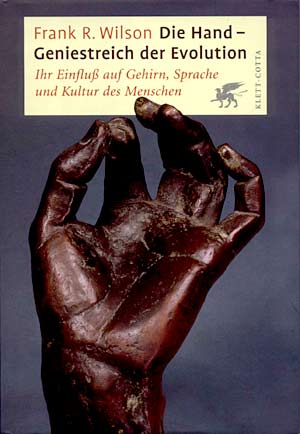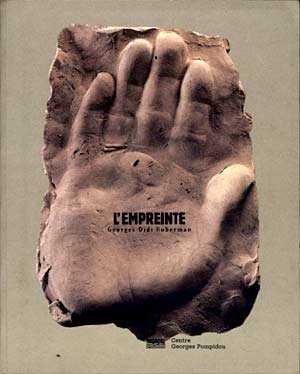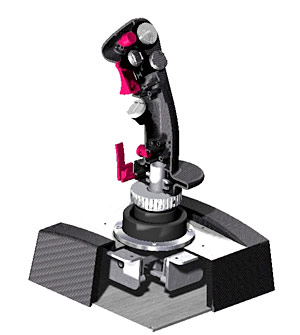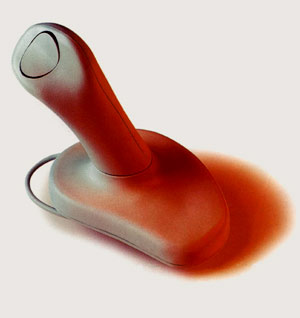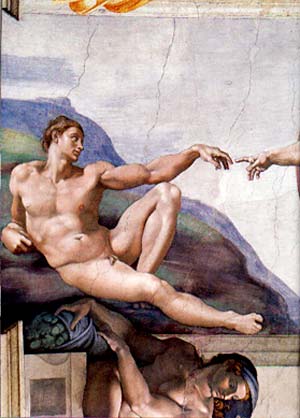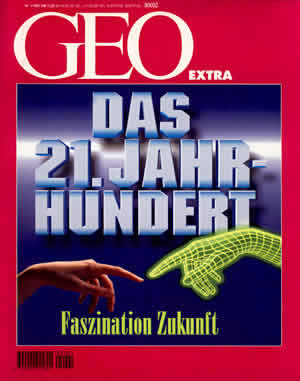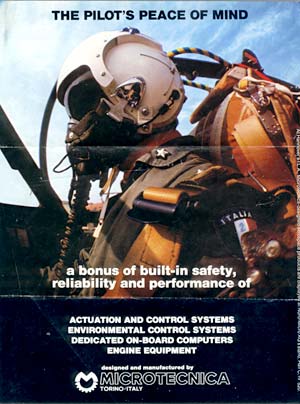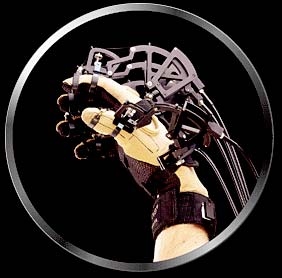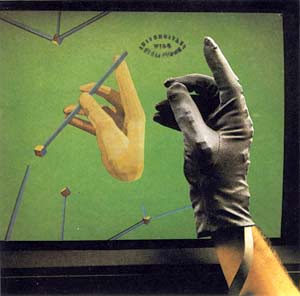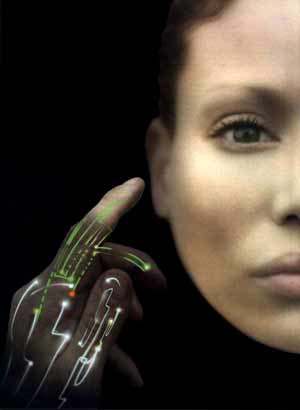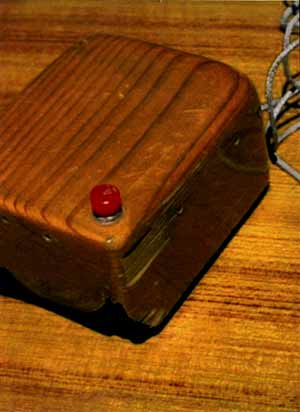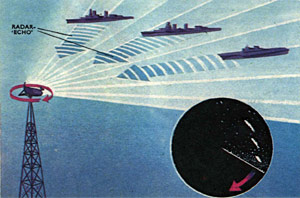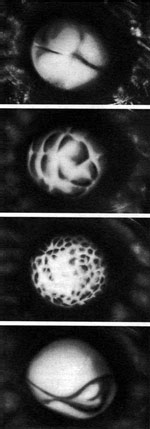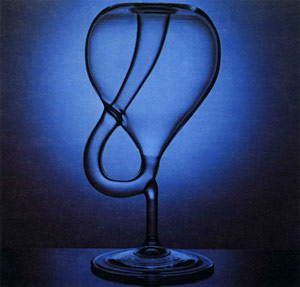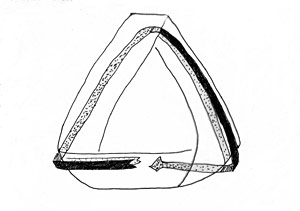| |
|
Claudia Reiche
The Avatarian Hand
Conditional Jump Instructions >>1
I grasp, therefore I am - this variant of the Cartesian Cogito is lately said to make sense according to neurological theses trying primarily to derive the cultural evolution of the human from the manner the hand functions (fig. 1).>>2 However, the hand's popularity thrives also in theory creations of different disciplines >>3 and in the popular image world. On the occasion of his exhibition on "Imprint" Georges Didi-Huberman describes the cultural technique of a physical and not just optical reproduction as a similarity by contact - and this hardly avoidable under the cover image of a hand imprint (fig. 2).
It touches, therefore leaves traces - would possibly be the short formula here. What about the following formulations for the currently dominating digital media format: I click, therefore I navigate through virtual worlds - or maybe from a media-theoretically more differentiated perspective: it clicks, therefore: who or what navigates where - or does it navigate me? These ambivalent messages can be found all over again as images in computer and trend magazines, for example in form of the latest virtual or physical doppelganger of the human (fig. 3).
Images of the most attractive input-devices, like different joysticks or data gloves, up to tele-robotic manipulators (fig. 4, fig. 5) can be found on a regular basis. Modifications of Michelangelo's famous fresco "The Creation of Adam" are often used in advertising and illustration and therefore make clear that such interfaces to the Digital designed for the human hand just like robotic and virtual hands are supposed to function as icons of a new human - thus the divine hand touches a robotic hand, computer-mouse or pixeled hand of a digitally determined Adam (fig. 6, fig. 7).
Such a creative imprint that creates and invigorates a similar body could insofar have assumed the ergonomic forms of joysticks that nestle into the human hand like an imprint - and are designed like triggers from combat planes. This would also be a precise media-archaeological return to the first occasions for cybernetic calculations. After all, it was Norbert Wiener who in the World War II let the trajectories in their future development be calculated by machines in advance to meet German fighter-bombers where they would have been, if no defensive rocket had hit them there. "Therefore it is of utmost importance not to fire a missile at the target, but to fire it in a way that missile and target meet at a specified moment later." >>4
Would that mean: I click, therefore my missile - at an uncertain location in a future not yet experienced - will have arrived? In the real or the virtual? Does a hit then certify the collapse of this world of statistical pre-calculation with 'real life'? Not without a rest, I would say. As less as this I that grasps, therefore is. Ever since the implementation of the conditional jump instruction, of feedback-loops for the automatic calculation of the immediate future, it is asked with a new intonation: Who acts? (fig. 8) "Just one single feedback loop - and information machines run away from the humans, their so-called inventors. Computers then become subjects." >>5
Which imprints did swap between the so-called inventors and machines? God is a computer? Give me high five, if the universe functions as an automate with on/off-switches.
Are we here at a different location, in front of or within in a representation? How is the contact between the fingers of one hand and triggers of different form to be localised epistemologically? Which space opens here? To understand this strange interspace - between different times, spaces and modes - is tried to achieve in concretion as the following examples show.
Feeling Data
Feature stories from computer magazines connect electronically stimulated hand functions with a new corporeality:
"Do you know what Force Feedback is? Imagine: You meet with friends in the net and you can shake hands for farewell. Or your screen can suddenly be grasped: You can touch all things on it. (...) [The] company Virtual Technologies ... has specialised on products like CyberGrasp - a glove used for touching graphical objects in the computer." >>6 (fig. 9)
Thus, the absurd is promised: being able to grasp into the computer and to feel at the same no plastic case or cards but the objects presented as images!
Do you know what force feedback is? The following quote offers a more objective explanation:
"Force feedback forces the cybernaut for example to perform certain movements in a data glove and thus conveys ... the feeling to act with a real world object. (...) Force feedback is a simulation of pressure, power or vibration." >>7
The following setting that has already been realised in its beginnings offers a possible illustration: if, for example, a cybernaut explores a virtual representation of the human body with the Force Feedback-glove, force feedback consequently creates the impression of soft areas (e.g. the stomach) or hard areas (e.g. the head), providing that this virtual body is modelled precisely. Rhythmic vibrations could be felt at the carotid artery - and should this virtual human then lift the arm the cybernaut's hand would probably be energetically pushed back. Faced with this scene an outside observer would however only be able to recognise a weird pantomime: someone would gesticulate in the air with gloved hands and mechanical guidance and transmission elements.
If a Force Feedback-glove is seen as a tool "to touch graphical objects in the computer" with, a notion of simulation reaches this assertion, that originally was triggered by the force feedback experience in virtual reality - like an elastic movement to which the concepts of the computer, body and the represented visual and tactile objects would be subjected to. Here, it is all about a deformation of the conception of space in the setting of subject, machine and representation. A question of the limitations of the body is being posed. Although the force feedback of the glove can be objectified, the following subjective perception to touch a material object is however imaginary. Based on a 'close-up' sense, depending on physical contact, is tactile perception during a virtual handshake an experience hard to believe, contradictory and haunting - in contrast to more practised deceptions like the ones of the 'long-distance' senses, especially the eye. The following remarkable terminus technicus is possibly motivated by this eerie, strange presence with tactile simulations: a tactile simulated object is simply called phantom.
The interference of a sense-able 'being here' of a three-dimensional body with a 'being there' of an image representation merges into ambivalent interpretations. However, the description of the CyberGrasp-glove suggests the repetition of an every-day experience: grasping an object coordinated by the eyes. But the spatial arrangement of every visual-tactile simulation proves that to be wrong, because I have to touch every virtual object at a location different from its image. By diverting my eyes from the display directly to my hand I see the tactile simulation functioning in the empty space. There I sense something where obviously nothing is located, not even the image. >>8 This Cyber-Grasp into the emptiness must now be filled in an imaginary way: The arrangement demands and enables the bridging of this obvious difference by imagining homogeneous objects to which the impressions of sight and touch are allocated.
Another element, an image, is requested to offer an image-representation of the own hand and indicate how the virtual object can be touched or manipulated. Such representations are called avatars which in the Indian origin refers to the 'descendance of a god'. In this case the 'own hand' works as the representative for an entire person. In most cases is an incarnation of the god Vishnu into animal or human shape specified as Avatara (fig. 10, fig. 11).
The representational logic is here left behind - just like with the phantom. An incarnation does not refer to an image-becoming in the representational sense but rather to a materialisation of a divine being in different living shapes. Even if a two- or three-dimensional image representation appears on the computer display, according to etymology a magical image is referred to that claims no similarity but identity with the god coming in the flesh. Just like Vishnu is still Vishnu in shape of a boar, turtle, fish, man-lion, dwarf, hero with an axe, moon-hero, hero with the plough and as Krishna, our avatarian representations on the display shall also remain hand and own body. Such a standard was also applied to the phantom of the virtual arrangement: spatially separated yet corporeally connected with the visual representation of the object in question as well as with the body of the telepresentic partner in handshaking. From where the hand touches the glove and the emptiness the illusion emerges to touch a solid object - translated into the phantasm that the simulated or the telepresentic counterpart (just like me) is present as ghost or god.
This spectre- or spirit raising in the face of new media-technological possibilities has a certain tradition because the respectively latest medial techniques develop otherwise too rigid testing laboratories for human psyche and physique. The force feedback-arrangement demands a training to identify a hand-avatar with sensations of the own hand. The knowledge about location and movement of the own hand in space by proprioception is linked to the calculated movements of the hand-avatar at the virtual object on the display. These perceptions must be brought into the greatest accordance possible by learning the technologically specific system. Otherwise, does the technical arrangement itself remain in the focus of what is perceived. The hand in the force feedback-glove has to get used to working with the respective hard- and software constellation just like to a complicated prosthesis with tricks and limitations. That means that training has to effect the merging of avatarian image with the body image of the own hand as well as the interplay without 'friction' of avatar and phantom.
A double movement is requested here that can be logically called a mistake. For if the image created is that convincing as if the avatarian image of my hand could feel something, then a border has been crossed, the differentiation between myself, the images and what they represent has been crossed.
It could also be formulated as follows: the tactile simulation of the phantom effects the own body's change into a reciprocal phantom and the tactile affirmation of the body's presence can then be interpreted as an illusion. Consequently can the affirmation of one's own presence here and now no longer give an apparent certainty about being here, one's own body and the ego due to the tactile self-perception of the body. This would be a conclusion interpreting the experiences in tactile simulations not as divination of the ego but bearing and using them as dis-illusion. Substantiality and homogeneity of the ego would have to be regarded as the effect of a border area, a rim: as skin. Such skin would no longer enclose my body but would be designed "pour nous faire relativer les prétendues trois dimensions de l'espace, seulement fondées sur la traduction que nous faisons de notre corps en un volume de solide." >>9
Such skin would not separate the inside from the outside, and in further metaphysical projection would not separate body from spirit, essence from presence, subject from object, male from female, phallic from castrated. >>10 This skin would create a surface - in a space of different properties.
For some decades now have female artists and scientists raised the according questions. In Laurie Anderson's words "I mean, where do you end and where does the machine start?" >>11 or in Donna Haraway's ironic version as the question for the 'should': "[W]hy should our bodies end at the skin?" >>12 Or: why should machines end at their cases? Why should data end at their carrier or output device? Feeling data - this formulation could allow data being grammatically read in the object as well as in the subject position and after some thinking even cross every of the oppositions mentioned above too.
Avatars
"Imagine you look at your hand but your hand is the one of a frog. Shocked, you move it to check, whether you belong to this hand; and yet it obeys. And in the next moment you possibly design your hand as one of a lion, as a talon of a bird, or you move as a mouse in a trap." >>13 Says Jaron Lanier, pioneer of virtual reality, in an interview. The potentials of computer-generated worlds are again presented to our imagination manifestly, as 'grasped by the hand'. Though the reaction here seems to be one of a precarious, shocked self-ascertaining. The mentioned shock lies in the uncertainty whether 'it' is still my own hand and if it still obeys my will in the avatarian representation. The representation of movement is however always slightly delayed even if the processor provides output in real time. The delay is to be sensed and can be very irritating, but can shock only the one who recognises himself in virtual representation and perceives a difference, who reflects himself in the new imagery trying to accept this grotesque shapes as his owns. That is the only way to explain the logically demanding statement: "You look at your hand; but your hand is the one of a frog."
This graphical il-logic perceives and produces the computer display as a special mirror; here the experience in virtual reality is based on a deception in the imaginary which ignores the separation between image and what it represents. This logically wrong formulation should at least specify correctly what is scandalous about this new experience. (fig. 12)
On no account can we refer to this as a single case of a heavily suggestive perception of the own hand in virtual reality. "The hand that floated in the virtual world was more than a hand. It was me." >>14
- specifies Howard Rheingold his first experience with a data glove to the point of the illusion dealt with here. The following statement summarises it in a more analytical way:
"As a point of reference for our own location in cyberspace, the virtual hand ... is both evocative and functional. It is compelling to see your virtual fingers move as you wiggle your hand. Watching your dynamic self-representation within the virtual worlds is convincing evidence that you're There." >>15
We are supposed to be convinced that we are where? There, in capital letters. Which extent, which properties does There have? It is specified as "in or at that place (opposed to here) ... at that point in an action".>>16 Does that mean that we are convinced to be over there - in virtual reality? Or that we sense to be There, emphatically and with capital letters: as with a certain "startling spectacle" of an infant in front of the mirror as introduced by Jacques Lacan? The "jubilant" assumption of the reflection recognised for the first time as "I" is described as "mirror stage" and is supposed to transfer the child into a different stage by means of identification with the assumed reflection. "Il y suffit de comprendre le stade du miroir comme une identification au sens plein que l'analyse donne à ce terme: à savoir la transformation produite chez le sujet, quand il assume une image,...." >>17 Along with such a change can a spatial confusion between the two sides of the mirror be observed: here and there are united for appearance, to the there of the I
I as Point / Movement
If a reduction on the basic principle of an avatarian hand is attempted for once, the dimensions of the avatarian image are mathematically brought down to zero and just a single point remains. A point following the hand's gestures despite the initial shock about its status - a point loyally shifting its position on the display in accordance with the gestures at the input device had its big coming-out already in 1968 when the first version of the computer mouse was demonstrated (fig. 13).>>18
In a presentation the jubilant effects of which still echoing today>>19 the participants of a big computer conference in San Francisco were confronted with something that is today only slowly realised as thinking of an information space. The essential medial forms of contemporary computer conception have then been invented far too early - at a time when computer was mainly conceived of as a calculating machine existing in form of some few machines of room-like proportions with digit input via punched cards and output via printers..>>20 In the 50s of the 20th century processors did not yet have a display with the exception of advanced and partly secret research for example at the MIT.>>21
The display and processing of words on monitors alone was unthinkable for general understanding, as were the today normal pop-up windows which include graphic fields for the processing of different tasks. Completely new was the networking of different computers, browser, E-mail and video-conferencing. In 1968 all these functionally decisive new creations were introduced as functioning devices and programmes by Douglas Engelbart at the legendary presentation.
The mutual basic idea for these new concepts was based on the computer display's perception as a mirror. The most important property of such a mirror is to display the subject's representation and the representation of processing operations as a dynamic, moving image of a change in space and time. Which means: The basic idea founds on the representation of a moveable point, because the then introduced first mouse cursor was represented as a point on the computer display. This zero-dimensional, void-of-extent representative of something constitutively empty like the subject or data offered the possibility to identify with and to place oneself into this weird There the display showed and at the same time offered the possibility to dodge the structures of misreading that the identity function of a mirror lures with.
The graphic quality of a spatial projection for an imaginary positioning in the new image space of data is as effective as a mirror reflection. Not only are the body's space and the image space of data representation performatively constituted, but the reduction of the body image to the point's most minimal form introduces exactly in and at this special point an ambivalence between a visible similarity and a representation of something essentially invisible - there. The interpretation of measuring data of movements lets hand and mouse cursor appear as visibly similar; the human hand however is not similar to a point. The mouse cursor shows the point-like projection of the acting subject into the information space that has become image - process-like, without extension, disappearing.
As a radar engineer in WW II Douglas Engelbart had looked at cathode ray tubes that showed a graphic representation of the local geographic situation. As a conception, Engelbart's idea to make words and images visible and ready for manipulation in the processor has also a lot to do with radar procedures. Even with most unfortunate visibility 'Radio Detecting And Ranging' makes possible a model-like visual reconstruction of the surrounding space by sending an electro-magnetic wave and timing its echo. The radar's principle "relies on the reflection effect of directed electro-magnetic waves that can again be received if reflected by an object. The difference in time or frequency between sent and received signal allowed to specify direction and distance of the located object." >>22 (fig. 14)
Periodically shifting points of light set off signs of measuring points directed relatively at each other. These points have no spatial extension but are calculated according to the time difference in transmission and reception. Then the measuring points are however interpreted in relation to the present location of bodies in space, as if they were their physical imprint. From this abstract movement-based representational logic on a round radar screen it is no longer far towards Engelbart's vision of humans "sitting in front of displays, 'flying around' in an information space".>>23 The data imprint of the enemy plane or the targets coming nearer during the approach must only be replaced with the point-like, disappearing movement-representation, the trace left by the subject in the information space.
As the data operations in Engelbart's vision moved beyond the closed concept of the large, static computer into the net-like distributed system of many terminals that can be switched and executed variably, information space was understood as something moving, even as a form-changing paradoxical data body at the border between hardware and imagination. A performatively realisable accessibility and omni-presence of data infected statuary identifications. Information apace realised itself as a space without from, variable and never to be incorporated completely. Thus this space forms the necessary complement to the idea of the subject as a moving point without extension.
Matching this idea is the fact that the very first computer mouse of 1963/64 had two rolls on the bottom side forming an angle of 90°. The screen's horizontals and verticals were materially transferred insofar the axes of both wheels incorporate the mathematical properties of the co-ordinates: the property infinity. As does the potential space of the display that indicates only a section, a window of the formless information space adjustable at will. So this can happen, if radar screens are connected to processors and calculations become images.
Topology per Hand
"Embryology makes it easier for us to bid farewell to so-called logic ways of thinking. By 'invagination' of one of its poles in the gastrula-stage the embryo takes the form of a pocket and consists of two leaves, the ectoderm and the endoderm. (...) The skin (including the sensory organs) and the brain are formed out of the ectoderm (...) Brain and skin are of the nature of surfaces. The inner surface ..., the cortex, is in relation with the outer world mediated by an outer surface, the skin. And these two shells consist of at least two layers where the outer of which assumes a protective function and the one beneath it acts as a filter with the function to store information and to conduct its exchange." >>24 (fig. 15)
Such embryonic turning the inside out delivers an image describing the skin's surface as information space in Engelbart's understanding. From a developmental-biologically view this image also questions the spatial conceptions of an inner and outer side as guarantee for an intact body image. There is a mathematical discipline researching such elastic deformations: topology. The topological space often requires four dimensions that can no longer be drawn according to perspective and are located beyond what can be imagined in image and space, because the separation of the inner and the outer side is no longer to be found with certain topological operations.
"This results in a 'pseudo-imagination' of R4 [four-dimensional, C. R.] bodies that makes you think of a drawn figure all questions for location relations, dimensions ... can be read on or be derived from in thoughts." >>25 In contrast to Euclidean geometry only researching rigid movements with plane and spatial figures, such as parallel translations, rotations and reflections, the permitted movements in topology can be called elastic.
"We can imagine our figures been made from completely elastic rubber allowing us to stretch, compress, twist and distort a figure at will while moving it. We can even cut apart such a figure from rubber and to knot it together, if both interfaces are linked together as they were before. (...) [T]wo figures are topologically equivalent, if one is congruent with the other due to an elastic movement." >>26 (fig. 16) Insofar it would also be allowed to turn out a hollow sphere from rubber making the inner side the outer side. A more elegant manner of a topological eversion without having to call upon cutting apart and re-linking lies in using the fourth space dimension.
"In R4 we could for example make a left glove into a right one by such a rotation [a reflection at a plane, C. R.] without turning his inside to the outside. With an R4 at our disposal we could restrain to one sort of shoes, like the right one. Even shoe laces would no longer be necessary; we could slip our feet into tied shoes simply by the fourth dimension." >>27
After discussing such everyday examples we will turn to the most prominent topological figure, the Moebius strip, and will see that far more complicated tasks will confront the imagination. A Moebius strip is created by cutting and twisting a cylinder piece by 180°. Its properties are such amazing ones as being a surface with only one side and only one edge. Mathematically this property is called: non-orientedness. Some similarities to the ones of an avatarian I-simulation in virtual space can be found in these characteristics.
This can be further illustrated and focused by a thinking experiment.>>28 Imagine a Moebius strip consisting of a semi-permeable mirror: you can look through it and you can see the reflection at the same time. If we positioned ourselves in front of the reflecting side and had an elastic arm we could like to conduct the following playful examination - to move this arm along the Moebius strip back to the head. Let us assume the head would now itch. But not matter how intensive we would scratch our head with the long elastic arm, nothing would be felt. In this arrangement the arm would only scratch the image of the head and the image-arm would scratch the head (fig. 17).
Because the mirror is just a one-sided surface the imagination moved the arm behind the mirror. In mathematical terms however there is no front or back of the mirror in this example. The three-dimensional space passed by the elastic arm following the Moebius strip has facilitated the experience of a non-orientedness through the semi-permeable mirror. The arm directly protrudes into the representation, the image category as well as the body can no longer be restricted according to usual space conception.
How could one then scratch one's head, if the arrangement would persist as it is ? Well - the arm would have to be stretched twice as far as before. If the arm would again follow the twists of the Moebius strip, another round on the Moebius strip would again lead to the head. Would we have reached our body again? It appears this can be doubted - how would it look anyway, if we looked into the mirror?
This twofold orbit around a one-sided surface rather creates a multitude of views, through the mirror itself as well as the mirroring reflection. One would see three arms, if we could again feel our fingers scratching our head: two direct views of our elastic arm, one apparently from the front, one apparently behind the semi-permeable Moebius strip and one reflected version. In my opinion such a fantastic situation reflects far more convincingly the relations of a body in a visual-tactile simulation as the continuously conjured imagination to directly intrude into virtuality through a mirror become permeable. Here, just the misreading function of the mirror has been tripled.
This topological, hypothetical model of the reflecting semi-permeable Moebius strip would also answer the question of Laurie Anderson and Donna Haraway with respect to an experimental topology between the functions of eye and hand whose difference determines an information space like a data body. A data glove turned inside out or handprints eternalised in form of a joystick would no longer suffice here to manifest the scandalous eversions of the gender relations let alone the maintained obsoleteness of the body in the information age.
The avatarian hand would correspond to the reflected vision of the arm, the tactile phantom to the apparently double yet single round of the arm through the strip's twisting. The own body has disappeared in the logic of this model. And it did this in a visible and sense-able manner. Feeling data. I grasp, therefore I am not. What is the reason for it?
"J'en conclus que l'espace n'est pas intuitif. Il est mathématicien." >>29 Trivially enough this accounts for the information space. And: the simulation space of tactile and visual virtual reality acts like an one-sided mirror-surface: without front and back..>>30 Yet: It touches, therefore it leaves traces. It clicks.
Translation: Sabine Melchert
References
¬Laurie Anderson, Die primitive Kunst der Zunge. In: Literatur konkret, no. 12, 1987/88.
¬Marie-Luise Angerer, body options. körper. spuren. medien. bilder, Vienna 1999.
¬Anon., Greifen Sie zu! Mit James Kramer wird der virtuelle Raum begreifbar. In: Konr@d, Computer. Lifestyle. Zukunft, Hamburg, February, March 1999.
¬Didier Anzieu, Das Haut-Ich. Frankfurt a.M. 1991.
¬B. H. Arnold, Elementare Topologie. Anschauliche Probleme und grundlegende Begriffe, Göttingen 1964.
¬Hans-Joachim Braun, Krieg der Ingenieure: das mechanisierte Schlachtfeld. In: Hans-Joachim Braun, Walter Kaiser, Propyläen Technikgeschichte, Seit 1914, Berlin 1997.
¬Meredith Bricken, Virtual Worlds: No Interface to Design. In: Michael Benedikt (Ed.), Cyberspace, First Steps, Cambridge, London 1991.
¬Robert B. Costello (Ed.), Random House Webster's College Dictionary, New York 1992, 1384.
¬Donna Haraway, A Manifesto for Cyborgs. In: Haraway, Simians, Cyborgs and Women: The Reinvention of Nature, London 1991.
¬Georges Didi-Huberman, L'Empreinte, Paris 1997.
¬Friedrich Kittler, Grammophon, Film, Typewriter, Berlin 1985.
¬Martin Kubaczek, Der Erfinder in der Traummaschine. In: Gerhard Fischer, Klemens Gruber, Nora Martin, Werner Rappl (Eds.), daedalus. Die Erfindung der Gegenwart, Frankfurt a.M., Basel 1990.
¬Jacques Lacan, Das Seminar, Buch II, Olten 1980.
¬Jacques Lacan, Le Seminaire, livre XX, Encore, Paris 1975.
¬ Jacques Lacan, Le stade du miroir comme formateur de la fonction du Je telle qu'elle nous est révélée dans l'expérience psychoanalytique, http://perso.wanadoo.fr/espace.freud/topos/psycha/psysem/miroir.htm, last visit 07/08/2003.
¬Lektorat des B.I.-Wissenschaftsverlags (Ed.), Duden, Informatik, Mannheim, Leipzig, Wien, Zürich 1993.
¬Tia O'Brien, The Mouse. In: Silicon Valley News, http://www0.mercurycenter.com/svtech/news/special/engelbart/part2.htm, last visit 02/14/2001.
¬Jean-Pierre Petit, Das Topologikon. Braunschweig 1995.
¬Howard Rheingold, Virtual Reality, New York 1992.
¬Stanford Center for Professional Development, Engelbart's Unfinished Revolution. A Symposium at Stanford University, 12/08/2001, http://unrev.stanford.edu/webstreaming/webstreaming.html, last visit 02/14/2001.
¬Stefan A. Völker, Virtual Reality in der Medizin I, Stand, Trends, Visionen, Mannheim 1995.
¬Roland W. Weitzenböck, Der vierdimensionale Raum. Basel 1956.
¬Norbert Wiener, Kybernetik: Regelung und Nachrichtenübertragung im Lebewesen und in der Maschine, Düsseldorf, Wien 1963.
¬Frank R. Wilson, Die Hand - Geniestreich der Evolution. Ihr Einfluß auf Gehirn, Sprache und Kultur des Menschen, Stuttgart 2000.
Figures
¬fig. 1: Cover, Wilson, Hand.
¬fig. 2: Cover, Huberman, Empreinte.
¬fig. 3: Cover, Spektrum der Wissenschaft, Dossier: Roboter erobern den Alltag, number 4, 1998, Heidelberg.
¬fig. 4: ThrustMaster, The news on Thrustmaster's up-and-coming Hands On Throttle And Stick products, http://flightsim.thrustmaster.com/articles/enlarge.php3?wichone=http://flightsim.thrustmaster.com/articles/
images/hotas_interview/f22-2000.jpg, last visit 02/03/2001.
¬fig. 5: Anir Pro mouse, AnimaX International. In: Wired, no.2 1998, Boulder, 51.
¬fig. 6: Christus Rex et Redemptor Mundi, Michael Olteanu, Capella Sistina, www.christusrex.org/www1/sistine/4d-Adam.jpg, last visit 02/23/2001
¬fig. 7: Cover, Geo Extra. Das 21. Jahrhundert, Faszination Zukunft, no. 1, 1995, Hamburg.
¬fig. 8: Microtecnica Torino, The Pilot's Peace of Mind, a bonus of built-in safety, reliability and performance ..., author's archive.
¬fig. 9: Virtual Technologies Inc., CyberGrasp, www.virtex.com/products/hw_products/cybergrasp.html, last visit 02/072001.
¬fig. 10: DataGlove and its virtual computer image. In: Fischer, daedalus, 65.
¬figure 11: Robert Nideffer, Tomb Raider Home Page, http://proxy.arts.uci.edu/~nideffer/crack/, last visit 02/20/ 2001.
¬fig. 12: The prosthetic limb of tomorrow will be wired directly to the user's brain. In: Scientific American quarterly, Your Bionic Future, no. 3, 1999, New York, 45.
¬fig. 13: The first mouse. In: Die Zeit, Magazin, computer spezial, no. 35, 1998, Hamburg, no page reference
¬fig. 14: By radiating the radar signal over a larger surface (by continually turning the directing antenna) the ships appear as fluorescent spots on the oscillographic screen. In: Sampson Low (Ed.), Der Erfinderische Geist. Grundlagen der wissenschaftlichen Erfindungen, London 1966, 7.
¬fig. 15: Development of the Alpine Water Newt. In: Hermann Linder, Biologie. Lehrbuch für die Oberstufe, Stuttgart 1971, 225.
¬fig. 16: This self-penetrating bottle from glass conveys a three-dimensional impression of an important surface not orientable known under the name of Klein bottle. In: Thomas Banchoff, Dimensionen. Figuren und Körper in geometrischen Räumen, Heidelberg 1991, 178.
¬fig. 17: author's drawing.
<<1 "Jump: instruction ..., having followed it a programme continues to work at a place determined by the jump target. (...) One talks about a conditioned jump, if it is only executed after having fulfilled a certain condition." Lektorat des B.I.-Wissenschaftsverlags (Ed.), Duden Informatik, Mannheim, Leipzig, Vienna, Zurich 1993, 684.
<<2 See e.g. Frank R. Wilson, Die Hand - Geniestreich der Evolution. Ihr Einfluß auf Gehirn, Sprache und Kultur des Menschen, Stuttgart 2000. "... the hand is not just a metaphor or sign for the humans' special abilities but a real core of crystallisation - the crucial point for a successful and fulfilling life", ibd., 22.
<<3 See Georges Didi-Huberman, L'Empreinte, Paris 1997. This exhibition in the Centre Georges Pompidou proposed the imprint as one of the oldest cultural techniques as an artistic and medial practice along to contemporary art including photographic storage forms. Corporeality is emphasised in imprints (in difference to the image).
<<4 Norbert Wiener, Kybernetik: Regelung und Nachrichtenübertragung im Lebewesen und in der Maschine, Düsseldorf, Vienna 1963, 28.
<<5 "IF a pre-programmed condition fails to appear, data processing continues according to the conventions of numbered instructions, IF however an intermediate result somewhere meets the condition, THEN the programme itself determines the following instruction, i.e. its future." That is Friedrich Kittler's interpretation on conditioned jump instructions. In: Friedrich Kittler, Grammophon, Film, Typewriter, Berlin 1985, 372.
<<6 Anon., Greifen sie zu! Mit James Kramer wird der virtuelle Raum begreifbar. In: Konrad, Computer. Lifestyle. Zukunft, Hamburg, February, March 1999, 16.
<<7 Stefan A. Völker, Virtual Reality in der Medizin I, Stand, Trends, Visionen, Mannheim 1995, 5 and following.
<<8 Augmented Reality will reunite representation and hand via transparency of the displays.
<<9 "...to let us relativise the alleged three dimensions of space solely based on the translation we use to subject our bodies to: a solid volume.", Jacques Lacan, Le Seminaire, livre XX, Encore, Paris 1975, 120-121.
<<10 Marie-Luise Angerer, body options. körper. spuren. medien. bilder, Vienna 1999, 144.
<<11 Laurie Anderson, Die primitive Kunst der Zunge. In: Literatur konkret, volume 12, 1987/88, 67.
<<12 Donna Haraway, A Manifesto for Cyborgs. In: Donna Haraway, Simians, Cyborgs and Women: The Reinvention of Nature, London 1991, 178.
<<13 Martin Kubaczek, Der Erfinder in der Traummaschine. In: Gerhard Fischer, Klemens Gruber, Nora Martin, Werner Rappl (Eds.), daedalus. Die Erfindung der Gegenwart, Frankfurt a.M., Basel 1990, 60.
<<14 Howard Rheingold, Virtual Reality New York 1992, 146.
<<15 Meredith Bricken, Virtual Worlds: No Interface to Design. In: Michael Benedikt (Ed.), Cyberspace, First Steps, Cambridge, London 1991, 366.
<<16 Robert B. Costello (Ed.), Random House Webster's College Dictionary, New York 1992, 1384.
<<17 Jacques Lacan, Le stade du miroir comme formateur de la fonction du Je telle qu'elle nous est révélée dans l'expérience psychoanalytique, http://perso.wanadoo.fr/espace.freud/topos/psycha/psysem/miroir.htm, last visit 07/08/2003.
<<18 In 1998 Engelbart's work became the topic of a symposium at Stanford University that can be followed on the WorldWide Web. Stanford Center for Professional Development, Engelbart's Unfinished Revolution, A Symposium at Stanford University, 12/08/1998, http://unrev.stanford.edu/webstreaming/webstreaming.html, last visit: 02/14/2001.
<<19 Determined as "Mother of all Demos". Tia O'Brien, The Mouse. In: Silicon Valley News, www.mercurycenter.com/svtech/news/special/engelbart/par2.htm, last visit 02/14/2001.
<<20 In 1941 Konrad Zuse's Z3 had already a complete keyboard. The enhanced teleprinter keyboard for the computer did however manage to succeed in the first half of the 60s in the 20th century.
<<21 At the end of the 50s of the 20th century the MIT worked upon the development of a computerised ground defence system (SAGE).The 'Whirlwind' Computer, developed in 1951, was used here with new installation possibilities. "...where high-speed calculations were combined with computer controls that resembled aircraft controls, and even a primitive graphic display. (...) Whirlwind and SAGE operators were the first computer users who were able to see information on visual display screens", Rheingold, Virtual Reality, 80.
<<22 Hans-Joachim Braun, Krieg der Ingenieure: das mechanisierte Schlachtfeld. In: Hans-Joachim Braun, Walter Kaiser, Propyläen Technikgeschichte. Seit 1914, Berlin 1997, 184.
<<23 O'Brien, Mouse.
<<24 Didier Anzieu, Das Haut-Ich, Frankfurt a.M. 1991, 7.
<<25 Roland W. Weitzenböck, Der vierdimensionale Raum, Basel 1956, 52.
<<26 B. H. Arnold, Elementare Topologie. Anschauliche Probleme und grundlegende Begriffe, Göttingen 1964, 12 and following.
<<27 Weitzenböck, Vierdimensionaler Raum, 67.
<<28 This example has been taken from the text-book in comic-form by the mathematician Jean-Pierre Petit. See: Jean-Pierre Petit, Das Topologikon, Braunschweig 1995, 60.
<<29 "I conclude, that space is not intuitive. It is mathematical", Lacan, Encore, 122.
<<30 This context allows the following statement to be read anew: "All possible things in the world act like mirrors. It is enough to have such conditions that one point of a reality corresponds with an effect at another point resulting in the creation of a bi-univocal correspondence between two points of the real space. I have said the real space." Jacques Lacan, Das Seminar, Buch II, Olten 1980, 67.
Translation: Sabine Melchert
Claudia Reiche: The Avatarian Hand / Die avatarische Hand, in: expand, white cube no. 1, interdisziplinäre Kunstedition der Internationalen Künstlerinnenstiftung Die Höge, Bremen 2003
|
|
|
